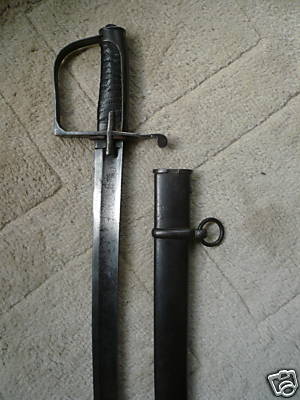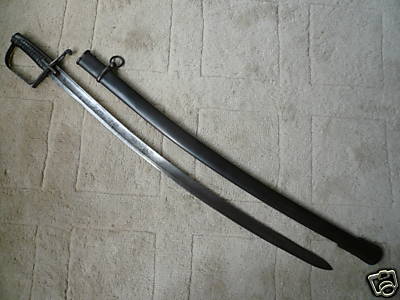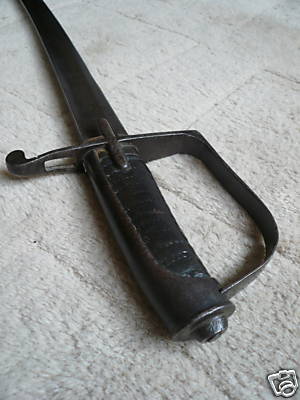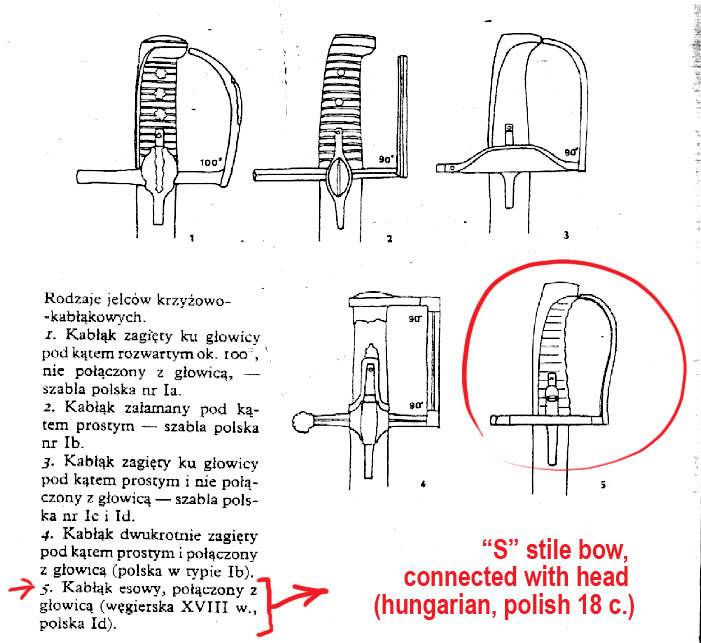| Author |
Message |
Morgan Butler

|
 Posted: Fri 11 Apr, 2008 8:35 am Post subject: Cavalry Sabre I.D. question, Fun for young and old! Posted: Fri 11 Apr, 2008 8:35 am Post subject: Cavalry Sabre I.D. question, Fun for young and old! |
 |
|
Can anyone guess Date and Nationality? Its 44 inches overall.
 Attachment: 20.75 KB Attachment: 20.75 KB

 Attachment: 18.58 KB Attachment: 18.58 KB

 Attachment: 19.41 KB Attachment: 19.41 KB

inkothemgard!
|
|
  |
 |
Morgan Butler

|
 Posted: Fri 11 Apr, 2008 8:47 am Post subject: Posted: Fri 11 Apr, 2008 8:47 am Post subject: |
 |
|
Scratch that, its 41 inches overall.
inkothemgard!
|
|
  |
 |
Shahril Dzulkifli

|
 Posted: Fri 11 Apr, 2008 9:32 am Post subject: Cavalry Sabre I.D. Question, Fun for Young and Old! Posted: Fri 11 Apr, 2008 9:32 am Post subject: Cavalry Sabre I.D. Question, Fun for Young and Old! |
 |
|
|
Morgan, I think the cavalry sabre pictured is a Hussar cavalry sabre, judging by its looks.
|
|
  |
 |
Morgan Butler

|
 Posted: Fri 11 Apr, 2008 9:33 am Post subject: Posted: Fri 11 Apr, 2008 9:33 am Post subject: |
 |
|
Apparently it also has the "WKC" with Knights helmet, maker stamp.
inkothemgard!
|
|
  |
 |
Morgan Butler

|
 Posted: Fri 11 Apr, 2008 9:36 am Post subject: Re: Cavalry Sabre I.D. Question, Fun for Young and Old! Posted: Fri 11 Apr, 2008 9:36 am Post subject: Re: Cavalry Sabre I.D. Question, Fun for Young and Old! |
 |
|
| Shahril Dzulkifli wrote: | | Morgan, I think the cavalry sabre pictured is a Hussar cavalry sabre, judging by its looks. |
I thought that too, but it doesnt seem to have enought curve to it. Also, I thought the particular "knights head" mark is a bit late period.
inkothemgard!
|
|
  |
 |
Russ Thomas
Industry Professional

|
 Posted: Fri 11 Apr, 2008 10:06 am Post subject: Posted: Fri 11 Apr, 2008 10:06 am Post subject: |
 |
|
Hi Folks,
It looks to me as if it might be a Danish Lancers 1816 pattern? The 1816 pattern was used up until the introduction of the 1843 pattern. And Kirschbaum & cie did make weapons for the Dansih military. Are there any other marks anywhere?
Regards,
Russ.
Carpe diem, quam minimum credula postero !
http://www.living-history.no
|
|
   |
 |
Morgan Butler

|
 Posted: Fri 11 Apr, 2008 10:10 am Post subject: Posted: Fri 11 Apr, 2008 10:10 am Post subject: |
 |
|
Not that I know about.
inkothemgard!
|
|
  |
 |
Glen A Cleeton

|
 Posted: Fri 11 Apr, 2008 10:29 am Post subject: Posted: Fri 11 Apr, 2008 10:29 am Post subject: |
 |
|
WKC, as an entity, did not exist before the 1880s. Is the sword actually marked WKC, or are you assuming the knight's head to be soley of that company's use?. Weyersburg and Kirschbuam were quite llosely associated throughout the 19th century but the knight's head was Kirschbuam's long before the partnership of the 1880s. weyersburg (of that context) used a crowned king's head. Early WKC blades sometimes used both marks. WKC actually has a decent mini history on their current website.
Books go a long way. I don't have good titles on German makers but there is a lot of overlap in resources I do look at. and titles I do own. Even Mike McWatters' pages will explain some of my thoughts above. Jonathan has Bezdek's title and may pipe in with some hard dates for use of the knight's head by Kirschbuam but iirc it predates partnership with Weyersburg by a century or more.
The sword is pretty much undeniably of Prussian manufacture and sabres of this type were used in many countries on both sides of 1800, plus or minus a few decades. I honestly wouldn't look to curvature to place a sword in time unless alongside the same sword model from a different period. The hilt type is pretty common by the third quarter of the 18th century and seems to phase out by 1810 or so. Mark Cloke's site might be useful as well. I have seen similar hilts listed to countries and states in and around that part of Europe.
Cheers
GC
|
|
  |
 |
Glen A Cleeton

|
 Posted: Fri 11 Apr, 2008 10:36 am Post subject: Posted: Fri 11 Apr, 2008 10:36 am Post subject: |
 |
|
Hi Russ,
Would the single scabbard ring place it better in time for Danish use?
Cheers
GC
|
|
  |
 |
Morgan Butler

|
 Posted: Fri 11 Apr, 2008 10:40 am Post subject: Posted: Fri 11 Apr, 2008 10:40 am Post subject: |
 |
|
Apparently it is stamped "WKC".
inkothemgard!
|
|
  |
 |
Russ Thomas
Industry Professional

|
 Posted: Fri 11 Apr, 2008 12:28 pm Post subject: Posted: Fri 11 Apr, 2008 12:28 pm Post subject: |
 |
|
Glen,
That got me thinking.....which is in itself a rarity!  , so I waded through my library, ( which unfortunately is still packed in boxes), for my copy of 'Gamle Danske Militær Våben' (Old Danish Military Weapons), by Th. Møller. In there it says that the 1816 pattern in fact had two rings on the scabbard ! So we can discount that theory. , so I waded through my library, ( which unfortunately is still packed in boxes), for my copy of 'Gamle Danske Militær Våben' (Old Danish Military Weapons), by Th. Møller. In there it says that the 1816 pattern in fact had two rings on the scabbard ! So we can discount that theory. 
Regards,
Russ
Carpe diem, quam minimum credula postero !
http://www.living-history.no
|
|
   |
 |
Glen A Cleeton

|
 Posted: Fri 11 Apr, 2008 1:53 pm Post subject: Posted: Fri 11 Apr, 2008 1:53 pm Post subject: |
 |
|
Hi Russ,
Thanks for the further information. I am not well studied on European swords but trends I have seen relate to the French moving to single ring scabbards in the 1850s. We shouldn't really judge by the scabbard either, as they not always original to the swords. Some scabbards even had rings removed to conform to later regulations.
Morgan's additional information that it does appear to actually be marked WKC only makes it seem less than likely an early piece but the characteristics really imply that it is early 19th century. The rather straight ; laced and cast stirrups being replaced with reverse P types cut from sheet long before WKC was formed. Again, I'm not well studied in 19th century European swords as a whole but I see a lot I would question as the sword being quite late. Polish or Hungarian maybe?
Cheers
GC
|
|
  |
 |
Konstantin Tsvetkov

|
 Posted: Sat 12 Apr, 2008 12:15 am Post subject: Posted: Sat 12 Apr, 2008 12:15 am Post subject: |
 |
|
Morgan,
It may be 1830 Saxon trooper's sword. Similar swords were exported by German makers to Italian states in the middle of 18-th century and a lot of them were used by Garibaldi troops. As far as I know, they were in production until the late 1800-s.
Konstantin.
Last edited by Konstantin Tsvetkov on Sun 13 Apr, 2008 1:28 am; edited 1 time in total
|
|
  |
 |
|
Kerim Mamedov
Location: Poland Joined: 21 Mar 2007
Posts: 53
|
 Posted: Sat 12 Apr, 2008 6:49 am Post subject: Posted: Sat 12 Apr, 2008 6:49 am Post subject: |
 |
|
Hi, I find this - page from "Polish sabers"
BTW, hussar blade can be more curved, but not necessarily
 Attachment: 136.04 KB Attachment: 136.04 KB

|
|
   |
 |
|
Jonathan Hopkins
|
 Posted: Sat 12 Apr, 2008 9:05 am Post subject: Posted: Sat 12 Apr, 2008 9:05 am Post subject: |
 |
|
WK&C or WKC 1883-present per Bezdek's German Swords and Sword Makers.
It has a strong resemblance to the Italian M1855 cavalry saber, but I really have no clue as to what it is.
Jonathan
|
|
  |
 |
|
|

